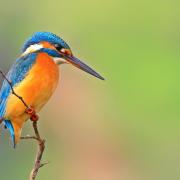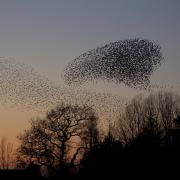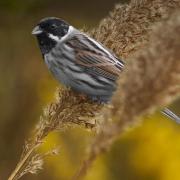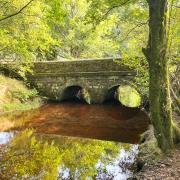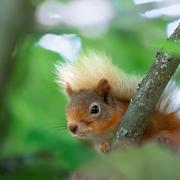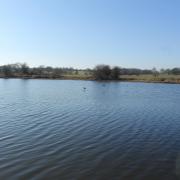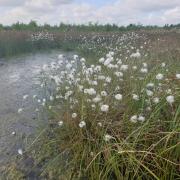Cuerden Valley Park is a wonderful rural oasis but it remains undiscovered to many outside the Chorley area. Terry Marsh reports
In the early morning light the flight of a kingfisher darting around the edge of the lake registers as a blurred streak of iridescent blue, a stunning sight at the best of times, but as it passes through a wayward ray of sunshine it explodes briefly into full colour before dulling again as it returns to shadow.
The hunched and solitary fisherman, three rods running outwards from the tent in which he’s spent the night, sees none of this, focused as he is on his orange-tipped floats towards which a great crested grebe is slowly paddling.
A different orange tip, this one a butterfly, is starting the day among the rafts of bluebell that are commonplace in the woods, around the edge of which rabbits and scratching pheasants are making the most of the tranquillity. The air is heavy with calm, and the sound of traffic little more than a distant hum; it is a delightful, refreshing Peer Gynt morning.
What makes the moment all the more special is that while the scene is evocative of many that might be encountered in the Lake District or the Yorkshire Dales, it is happening in the very heart of Lancashire, in the little-known Cuerden Valley Park on the edge of Chorley.
Central to the park is the River Lostock, a brisk and busy watercourse bound for the Ribble, and passing through estate land that once belonged to Cuerden Hall, now used by the Sue Ryder Foundation.
Amazingly, half a million people live within ten miles of this elongated 650 acre green oasis that stretches from Bamber Bridge in the north to Whittle-le-Woods in the south, themselves both ancient Lancashire settlements.
Newcomers are finding the park almost every day, astounded that they have lived ‘all my life’ in the region, but never knew that this lush and fecund wonderland even existed. Yet once you are in the park, surrounded by its lush vegetation, it is easy to forget that you are so close to residential areas.
Contrary to popular belief, the park is owned neither by local authorities nor by the Wildlife Trust (who have a presence in the park), but by a charitable trust, and, as such, is managed by a team of trustees and directors, with the able and enthusiastic support of ‘The Friends of Cuerden’. Alas, charitable status is not always a magnet for investment, and the trustees are constantly trying to make ends meet.
In 2009, the trustees produced a strategy document for the future of the park, one that made predictable but wholly valid noises about lack of funds, need to find public support, cost cutting efforts and more. But, these managerial considerations aside, what is important is that the park provides a much appreciated area of informal recreation, popular with walkers (and their dogs), cyclists, joggers, anglers, educationalists, geocachers and those who simply come in search of the abundant flora and fauna.
Part of the National Cycle Network runs the length of the park, which is also blessed with an extensive network of pathways and bridleways, much of it suitable for wheelchair access.
Coarse fishing is available on the lake and Cock Cabin Pond, and you might be forgiven for concluding that some of the anglers gathered along the banks have no homes to go to, such is the popularity of the place.
While it is not mentioned in the Domesday Book, Cuerden Park has a fascinating and colourful history, the earliest extant reference dating from 1199, when the lands and manor house were held by the Molyneux family.
Cuerden Hall, which is accessible from but independent of the park, was not built until after the Cuerden � residence at the manor. Over the ensuing centuries they developed the estate, constructing nurseries, orchards, plantations, meadows, fields and gardens.
Under the initial stewardship of Robert Townley Parker, by 1838 the parklands had developed into pasture with grazing animals, water meadows and wood plantations, creating a designed landscape. In addition, a footpath was laid across the estate. Further developments saw a new drive and gates, and a reservoir from the rivers and streams running through the park.
When Thomas Townley Parker, successor to Robert, died in 1906, the estate was left to his nephew, Reginald Tatton. He constructed more flower beds as well as a pergola and gazebo, a walled garden and pond. During the First World War, the Tatton family set up a hospital at Cuerden, furnishing it with beds and equipment.
After various changes of ownership, the parkland and wider estate metamorphosed into Cuerden Valley Park, and in 1978 plans were drawn up to shape the park to suit public use. In 1986, work began on developing the hall into a Sue Ryder Home, and the park was formally established as a charitable trust, by which time cyclepaths, bridleways and a new footpath circuit had been laid.
In 2003, discussions took place between the trustees and the park’s then managing agents, the Lancashire Wildlife Trust, about the future management and direction of the park. This resulted in the day-to-day control and management of the park being returned to the trustees and greater involvement by local people and stakeholders. A major restoration project began at the same time, aimed at restoring some of the Victorian features on the park, and this work is on-going today, as funds permit.
When such recreational gems languish within a short distance of our homes, there is an almost mandatory obligation on us to use them. With Cuerden many already do so, and enjoy the events and activities, including bird- and bat-watching tours, fungi forays and lectures, as well as an annual country fair, which will be held this year on May 22nd.
In Lancashire we are blessed with some outstanding landscapes and countryside, a heritage that comes in all shapes and sizes, from sandy beaches to river valleys, and windswept moorlands to woody glens like Cuerden. Why would anyone want to be anywhere else?











